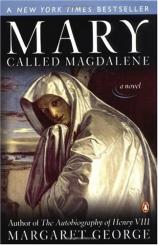About the Book
About the Book
Mary, Called Magdalene

Weaving together hints from the New Testament, Gnostic gospels, and other ancient texts, Mary Called Magdalene portrays the life of the mysterious figure of Mary Magdalene, "Apostle to the Apostles," and companion to Jesus. Here Margaret George creates a new portrait of one of the most controversial figures in biblical scholarship: a strong, independent woman, given to visions and gifted with a unique faith in Jesus and his message.
The daughter of a successful fish processor, Mary is raised in a religiously observant family in the town of Magdala on the Sea of Galilee. As a girl, she finds an idol made of ivory, an image with half closed eyes and sensual lips. Though it is against the strict Jewish teachings against graven images, she cannot resist its power and takes it with her, hiding it from her family. The idol turns out to be a demon, who begins speaking to Mary and then possesses her. Though she marries and has a baby girl, the demons that haunt her persist and multiply, until finally she is near death from madness. Seeking a cure, she leaves her family and small daughter. After a powerful rabbi is unable to heal her, she travels into the desert alone, determined either to be killed by the spirits that possess her, or to mount a final struggle and be rid of them forever. Soon after their victory over her, she comes upon a crowd of people gathered around a wild looking man preaching repentance: John the Baptist. It is here that she meets Jesus. When he commands the evil spirits to leave her, they do, and through this healing she is initiated as his disciple. The book's depiction of Jesus's travels throughout the region-with Mary and his disciples at his side-will be familiar to those acquainted with the gospels of the New Testament. Just as in the Gospels of Matthew, Mark, Luke, and John, the Jesus of Mary, Called Magdalene performs miracles such as curing blindness, lameness, and leprosy. George's interpretation of the message that Jesus has come to share with the world is simple and compelling: The kingdom of God is at hand, and to be prepared one must love God with all one's heart, worship sincerely rather than just for show, and love one's neighbors and enemies alike.
Assuming her family will rejoice at the good news of her cure, Mary is devastated to learn on her return to Magdala that her family has cast her out, and has no interest in Jesus's message. Now fully in the realm of fiction-the New Testament offers no details of Mary's personal life-George's depiction of Mary's family's reaction mirrors the Biblical reaction of Jesus's own family when he first returns home. Through these domestic conflicts George explores the themes of earthly versus heavenly family, and the necessity of sacrifice in any hero's journey. Early legends depicted Mary Magdalene as a reformed sinner or prostitute; recently some have speculated that she was Jesus's wife. Neither has any scholarly validity. George avoids both of these images, depicting Mary as a spiritual seeker and bereaved mother and widow, whose feelings for Jesus inevitably heighten over the course of their companionship, as she struggles with her desire for his love as a man, not just as a messenger of God. That Jesus is unable to offer her the earthly love she seeks compounds her suffering and sacrifice. George portrays Mary and the other disciples not as evolved beings like Jesus, but as mere humans suddenly faced with the opportunity to live a most unordinary life. Though Mary has the gift of prophesy, she fears her visions and the way they set her apart. Her gift-and her closeness to Jesus-inspires some jealously among the disciples, who, despite their faith, continue to struggle with their own pettiness and prejudices about the proper role of women. It is clear that often even Mary would trade it all-her visions and her special relationship to Jesus-to be the simple wife and mother she imagined she would be. Jesus, of course, is betrayed, executed, resurrected, and ascends to heaven, leaving Mary and his disciples to face the challenge of spreading the message without the messenger. Mary spends her life tending to the persecuted believers, always expecting Jesus's return. For the rest of her days, she struggles with the loss of her family and daughter. A gripping story of one woman's deepest despair and journey of faith, Mary, Called Magdalene explores themes of dedication and deliverance, the tension between romantic love and love of God, and the necessity of suffering and persecution to test the heart. Torn between her belief in Jesus's message, and the love for her family, her love of Jesus as a man and her love for him as God, Mary bravely and painfully remains faithful to her heart's calling to the truth. Through her example, George calls on us to consider life's biggest questions: what it means to be called by God, and how each of us might answer.
Mary, Called Magdalene
- Publication Date: May 27, 2003
- Genres: Fiction, Historical Fiction
- Paperback: 656 pages
- Publisher: Penguin (Non-Classics)
- ISBN-10: 0142002798
- ISBN-13: 9780142002797








